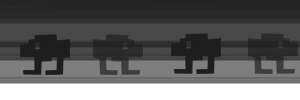Barely Visible Portraits: Part 3
Exhibitions, Paintings, Press Release
Clytie, 1973
Press Review and Catalog Essay
SOHO WEEKLY NEWS
October 31, 1974
On Art
Review by John Gruen
John Fekner (Hundred Acres, 456 West Broadway, NYC)
On first viewing the surfaces of John Fekner’s paintings, one wonders what in the devil he’s up to. Are they sensitive, calligraphic abstractions done with invisible inks? Are they barely perceived Japanese landscapes designed to make one myopic? And so, one looks and squints at these strange “blank” canvases, only to discover (if one looks hard and long enough) that Fekner’s little pen-squiggles form the outlines of huge, full-head portraits or group portraits, seen mysteriously emerging out of each canvas, like some hugely over-exposed negatives. The moment their revelation is made clear, the images come into subtle focus, and the paintings become astonishing. Clearly, these are exercises in perception, but done with such skill as to transform them into works of remarkable refinement.
__________________________________
From the catalog:
The Lewis Contemporary Art Fund Collection 1980
The Virginia Museum of Fine Arts, Richmond, Virginia
Catalog by Rebecca Massie
American, born 1950
Clytie, 1973
Ink on canvas
48 by 40 inches
Inscribed on stretcher upper right, “JOHN FEKNER 4/73 (CLYTIE)”
Acc. no. 73.101
With the patient of a Zen Buddhist calligrapher, John Fekner applied hundreds of small open circle to canvas, gradually developing the images of his “light” paintings. Like the Zen masters, Fekner worked in a process in which each unit (the small circle) is part of a greater whole (the portrait), the making of which requires great refinement of technique. Typically, a single painting took Fekner months and months of working five to eight hours a day. After projecting a carefully selected photograph onto canvas (using an opaque projector), Fekner would sketch a very basic outline of the image in pencil. Then he would begin filing in the dark areas with high-quality India ink, “building up the image as soft and quite as I could.” 1 Fekner discovered that working at night suited the mood of the final work, which is dimly visible, quiet, introspective, and non-aggressive. Clytie, for example, emerges from the canvas as a ghostly phantom of “an old time.” 2 Fekner fastidiously avoided over-finishing a portrait, for he considered a work complete when the image was barely resolved. “They are meant to exist like the fleeting images of dreams and memories; sometimes to be seen, or sometimes not to be seen-even forgotten.” 3
Now at work in Queens, Fekner has turned to making environmental conceptual art with the help of a grant from the America the Beautiful Fund. In this pursuit he hides the art in stenciled messages left on the wasted and destroyed remains of industry. Queens, his “ beautiful city of white factories,” 4 has been blighted by developing industry, broken communities, and people calloused by their daily contact with ugliness. As the quality of life is lowered for Queens’s residents, Fekner and his fellow artists at Public School #1 strive to rejuvenate beauty and to work against the damaging effects of an uprooted, nomadic technological culture.5
1 Fekner-Massie interview, Queens, New York, July 30, 1979, transcript in Virginia Museum files.
2 Ibid.
3 Fekner to Brandt, July 1978, Virginia Museum files.
4 Ibid.
5 P.S. #1 is an abandoned school building that was destined for demolition when it was converted into studios for artists. It was supported by the Institute for Art & Urban Resources, Long Island City, NY.
Read more
Barely Visible Portraits: Part 1
Barely Visible Portraits: Part 2
